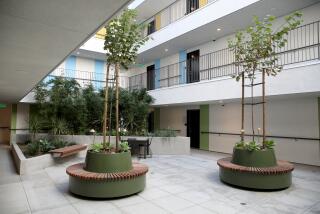Homeowner Fees Should Be Based on True Costs
Why are some homeowner associations financially sound, while others are barely paying their monthly bills?
Is the problem due to the original budget? Interim planning? The amount of dues? More important, is it possible to turn around a financially ailing homeowner association?
For the record:
12:00 a.m. March 25, 1990 For the Record
Los Angeles Times Sunday March 25, 1990 Home Edition Real Estate Part K Page 4 Column 1 Real Estate Desk 1 inches; 26 words Type of Material: Correction
Wrong measure--In the March 18 Speaking Out, “Homeowner Fees Should Be Based on True Costs,” the square footage per acre was misstated. The correct number is 43,560 square feet in an acre.
Before a subdivision is built, the developer is required to submit a budget for the homeowner association to the Department of Real Estate. Because budgets are prepared so early in the development process, they frequently include items that are never built and do not list items that are eventually included.
Because the budget approved by the Department of Real Estate is used by the association for at least the first year of its operation, an unrealistic developer budget tends to create an initial deficiency in the association’s original budget.
Naturally, home buyers find it more tempting to buy into an association with lower assessments. The message to those buyers is caveat emptor-- buyer beware! Suspiciously low dues frequently mean that there may be a problem ahead, with additional costs looming.
It is hard for the lay person to identify all the costs involved in a homeowners association, especially one without the most visibly expensive amenities--a guard gate, swimming pool or tennis courts.
But consider the costs of the following examples:
Do you have private streets?
Private streets mean that the association is responsible for sealing and striping the streets, 45 cents a square foot every three years; repaving the streets, 31 cents a square foot every 20 years; repairing potholes, 27 cents a square foot every four years, and sweeping the streets, $50 a sweep per acre (5,820 square feet).
Streets also add to insurance costs and may need to be washed down on an annual basis.
If the association owns the streets, it most likely owns the street lights as well.
This means maintenance for cleaning and bulb changes, electricity for lights that are on for an average of 10 hours a night, painting of light poles and eventual replacements for fixtures themselves, the cost of which is often alarmingly high.
If a pool, restroom, guard gate are added, the number of items in need of maintenance and repair multiply dramatically.
Another cost that is often overlooked is the running of the association itself. An association, which is a nonprofit corporation under California laws, faces at a minimum nearly 39% tax on interest income, insurance, audits and billings.
Don’t fool yourself; just like any other type of business, the simple cost of conducting association business is far more than meets the eye.
Members of homeowner associations should know that those seductively low assessment bills can threaten the future value of your home by endangering the financial health of your association.
The first few years of an association are critical to smooth money matters in the future. In addition, ongoing maintenance must begin the moment construction is completed. How then to know what must be maintained? What are the priorities? Where to start?
Initial maintenance is crucial. If, for example, your wrought iron within the community is not repainted in the first year-and-a-half at about 45 cents a linear foot, in time it probably will need to be replaced completely for about $21 a linear foot.
One of the best tools to assess these maintenance needs is the professional reserve analysis, which should be done by a firm that specializes in assessing the condition of each item--whether street, light fixture, pool plaster or paint on the entry sign--and determining the remaining life of that item.
The analyst will then assign your available funds to the items that are in the most urgent need of attention, and let you know what to fund in the coming months and years for future repair.
For example, if you have 100 light poles that each costs $100 to replace, that amounts to $10,000. If the poles have 10 years of remaining life, you must reserve $1,000 for each of the 10 years of remaining life.
In this fashion, as each item is in need of repair or replacement, the funds will have been set aside specifically for that purpose.
Associations that are financially sound have been following this method of funding for many years. Frequently, money is also set aside for emergency items or improvements to the common areas. Although this method almost assures financial health for an association, it is not required by law.
The California Civil Code only requires a homeowner association to annually mail to all members “the identification of the estimated remaining life of . . . those major components which the association is obliged to maintain.”
The code has two flaws. It allows anyone to perform the reserve analysis as long as it is reviewed by the board of directors, and it does not require the association to set aside the recommended amount of money.
One major obstacle to having enough money to set aside is a board of directors that does not understand that the association cannot properly function based on a fear of raising its members’ dues.
Many buyers of new homes are inclined to purchase within an association whose dues are low, not realizing that the low dues are a reflection of an inadequate original budget. They may have even been told by “someone” that the assessments will go down.
However, inevitably, the assessments must increase.
Many board members will mistakenly feel that they are doing the association members a favor by not raising the assessment dues when--in reality--a raise is needed. This in turn, causes the need for a special assessment--to pay for the items as required.
It doesn’t take a mathematical whiz to calculate the difference in asking the association members for the $10,000 for the light poles all at once in comparison to funding $1,000 a year (using an example of 100 homeowners, 84 cents a person each month).
If you are living in an association and the dues have not gone up for more than three years in a row, your board members are likely reacting to the fear--real or imaginary--that the members will be very angry with them if the dues go up by $15 a month.
What these board members need to keep in mind is that if they vote no to a dues increase, and in 10 years a special assessment is needed, angry owners can go back 10 years in the minutes to find out who was liable for not properly funding the association to begin with.
If the association needs money, and a needed increase is assessed, there has been no wrongdoing; if the needed increase is voted down by the board, negligence exists.
What if an association is in trouble already? Is there hope?
By proper planning, a troubled association can be helped through the use of cautious allocation of the funds it has--as guided by the reserve analysis, and by increasing monthly dues on a regular basis, if needed.
Current law allows boards to raise the monthly dues by 20% a year without the consent of the members at large. Naturally, an increase in the monthly dues is by far preferable to a special assessment, which is not made until there is an urgent demand for the funds.
By raising the dues annually as needed, items requiring repair or replacement or simply beautification can be taken care of in order of importance, rather than waiting until an emergency arises.
This holds true in car maintenance, human body maintenance and homeowner association maintenance.
Some associations are financially sound because they have been keeping an eye on their future needs, and budgeting accordingly. They are being cautious with planning and use the reserve study, and they are not afraid to raise their dues when needed.
Realize that your homeowners association is an integral part of your financial investment in your home--that the association is not just there to keep your dog quiet, but to protect and enhance the value of your home and your neighbor’s home.
More to Read
Inside the business of entertainment
The Wide Shot brings you news, analysis and insights on everything from streaming wars to production — and what it all means for the future.
You may occasionally receive promotional content from the Los Angeles Times.










